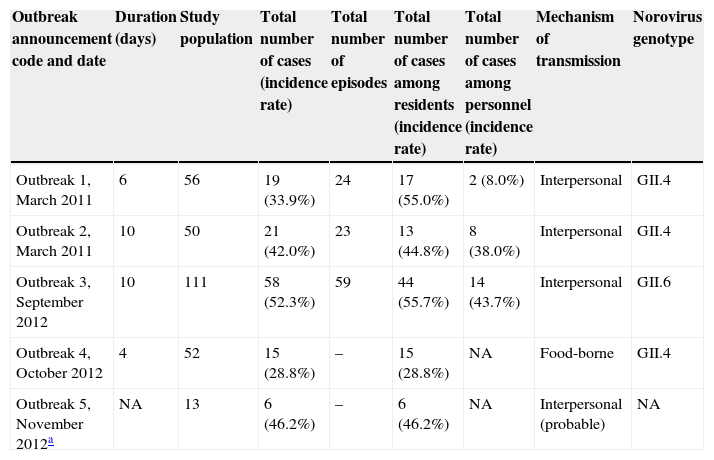Acute gastroenteritis (AGE) outbreaks of norovirus (NV) occur frequently in nursing homes. Gastrointestinal disorders and degree of dependence of residents complicate early detection and implementation of control measures. Our study's aim was to determine the incidence of NV in elderly care centres, transmission mechanisms and circulating genotypes.
Patients and methodsAn epidemiological study of NV outbreaks reported to the Public Health Agency of Barcelona 2010–2012 was performed. The attack rate, outbreak duration, symptomatology and identified NV genotypes were analyzed.
ResultsIn total, 27 NV outbreaks were reported and 5 (18.5%) occurred in nursing homes (95 cases with lethality of 1.05%). The aetiology of one of the five outbreaks could not be confirmed because of late notification. Four of the outbreaks were attributed to person-to-person transmission. The outbreak duration and attack rate among resident person-to-person transmission were significantly higher compared to common exposure transmission. Genotype GII.4 was predominant.
ConclusionsThe identification of critical points and the use of clinical alarm systems could prevent and minimize the spreading and severity of these outbreaks.
Los brotes de gastroenteritis aguda (GEA) por norovirus (NV) son frecuentes en geriátricos. Los trastornos gastrointestinales previos y el grado de dependencia de los residentes dificultan la detección y la implementación de medidas de control. El objetivo de nuestro estudio fue conocer la incidencia de los brotes por NV en geriátricos, las vías de transmisión y los genotipos causales.
Pacientes y métodoEstudio epidemiológico de los brotes por NV notificados en Barcelona durante 2010-2012. Se analizaron las tasas de ataque, la duración de los brotes, la sintomatología de los episodios y los genotipos circulantes.
ResultadosSe notificaron 27 brotes por NV; 5 (18,5%) en geriátricos, que afectaron a 95 personas, con una letalidad del 1,05%. El retraso en la notificación dificultó la investigación en uno de los brotes. La transmisión fue interpersonal en 4 brotes, cuya duración y tasas de ataque entre los residentes fueron mayores que en el brote de exposición común. El genotipo predominante fue el GII.4.
ConclusionesEs necesario identificar los puntos críticos en los centros y establecer sistemas de alarma para prevenir y minimizar la extensión y la severidad de estos brotes.







